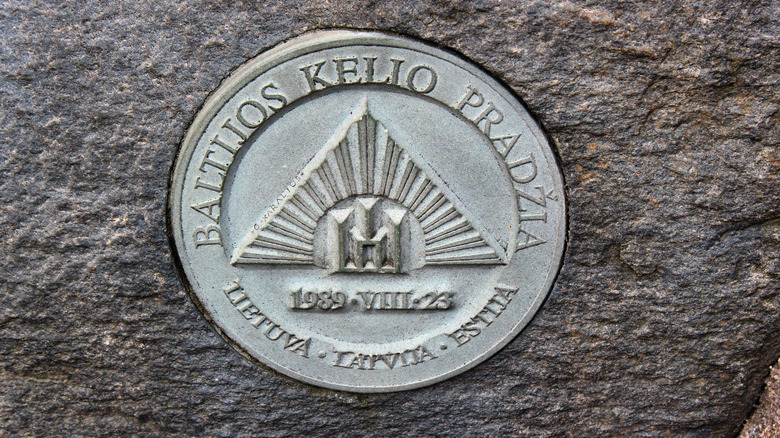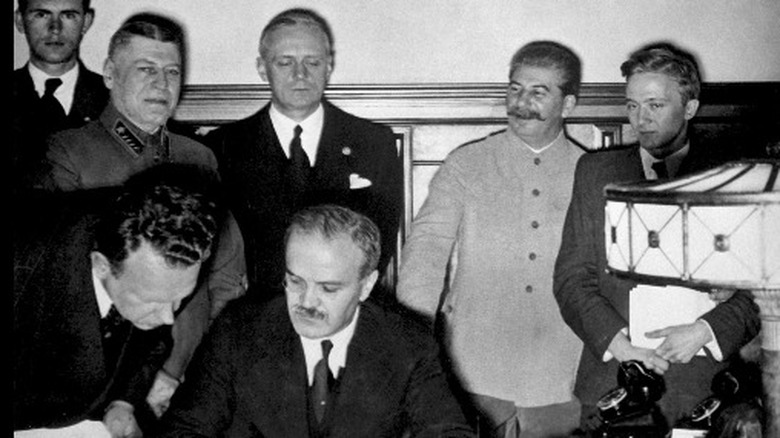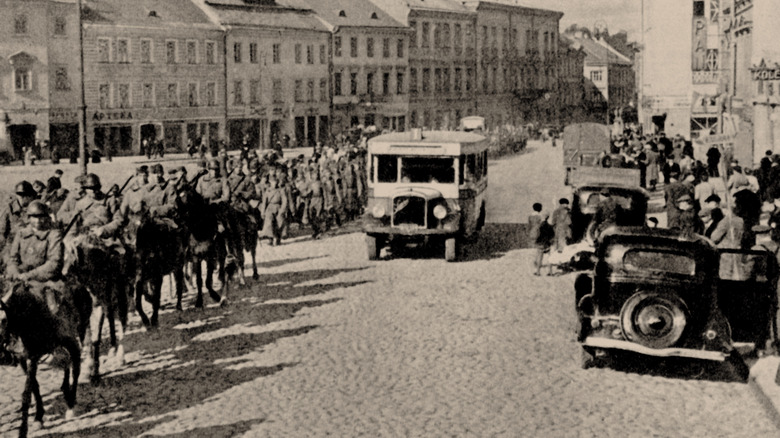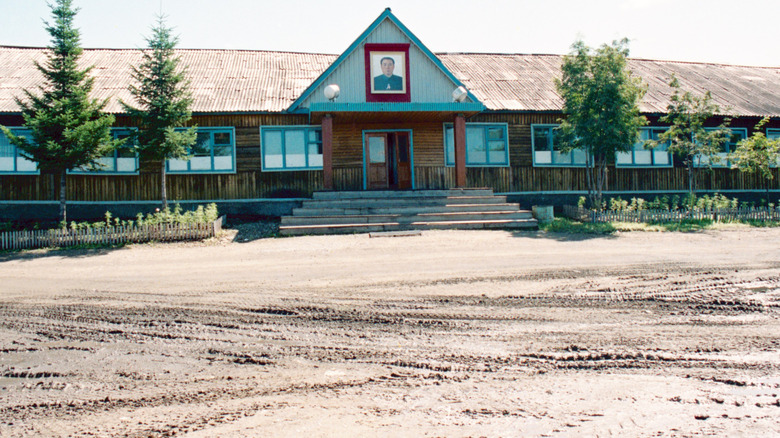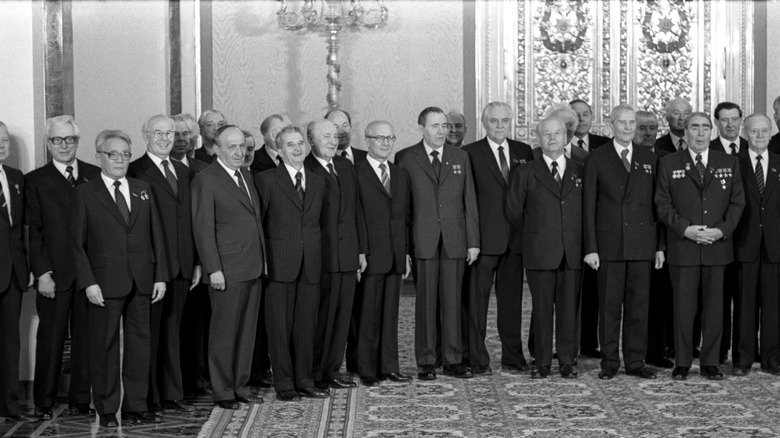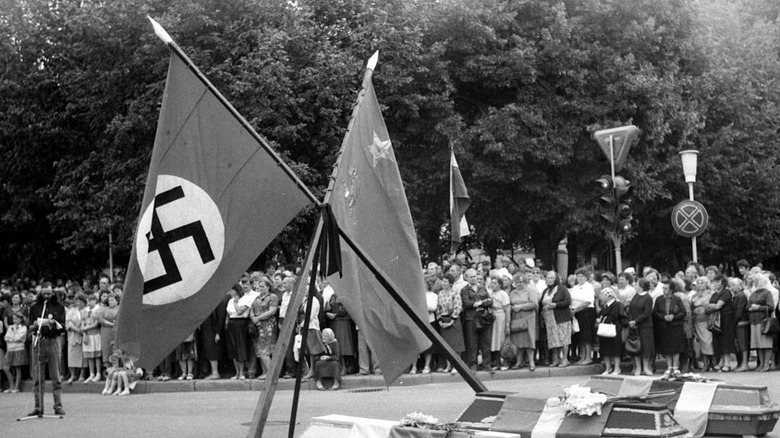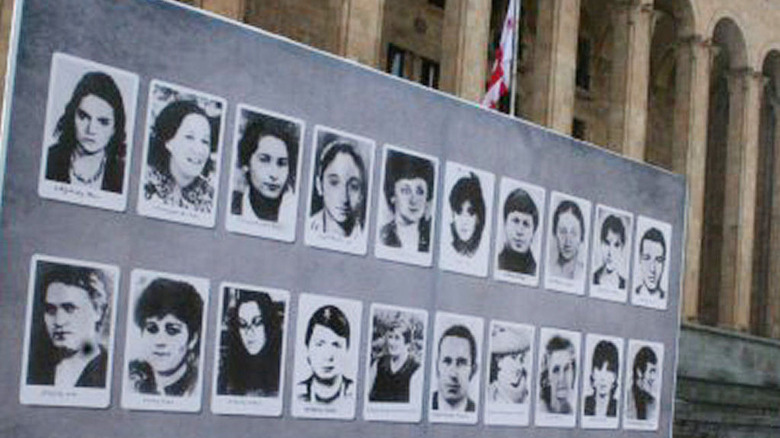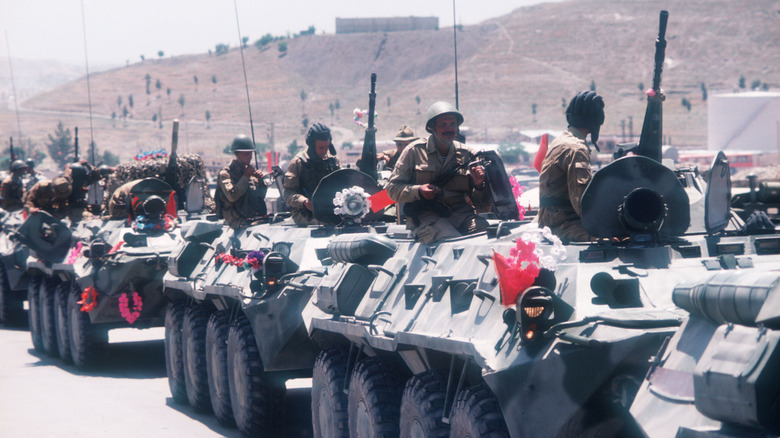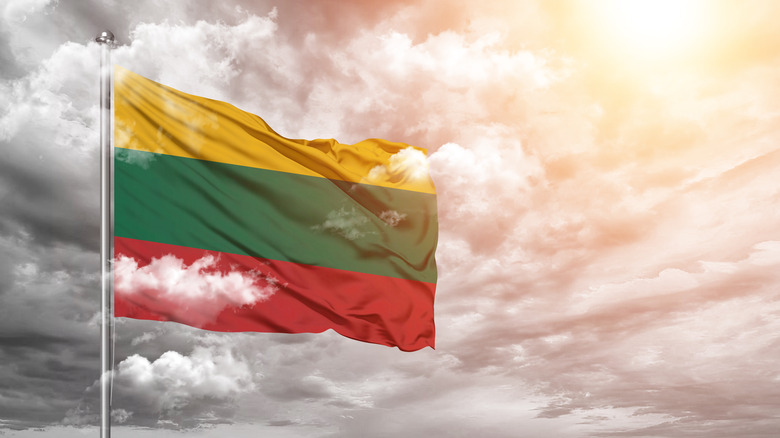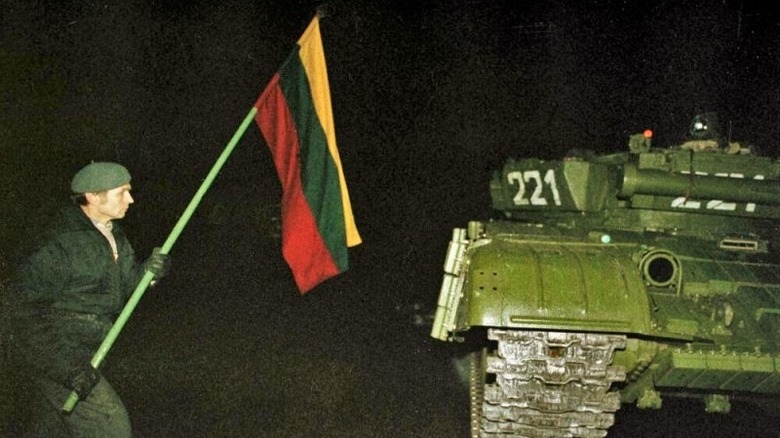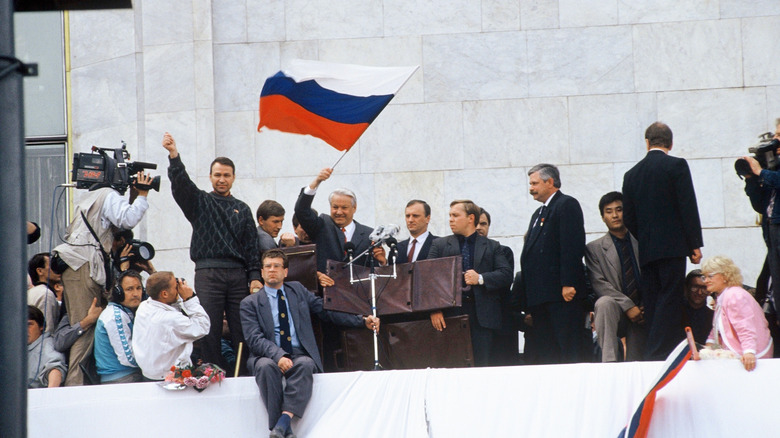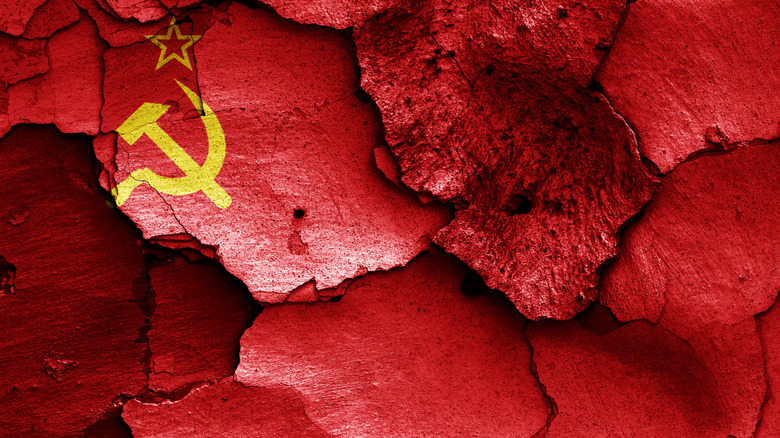The History Of The Baltic Way They Didn't Teach You In School
The Soviet Union had the reputation for whitewashing its role in the aggression that marked the period during the early days of World War II. According to Harvard University, Soviet (and now, Russian) historiography has portrayed the Soviet Union as a victim of German aggression. But the reality is that as Germany was annexing its way through Central Europe, the Soviet Union was engaged in aggression of its own, invading Finland in 1939 and annexing the Baltic states in 1940.
Following the Second World War, the Baltic states were incorporated into the Soviet Union following deportations and massacres of the local population. But the people of the Baltic never gave up, fighting a battle against the clock to preserve their native cultures against communism and Russification. Their efforts would yield results that no one could have ever imagined: the largest peaceful protest ever assembled in history and the eventual collapse of the Soviet Union.
The Molotov-Ribbentrop Pact
Understanding the Baltic way requires an understanding of the Molotov-Ribbentrop Pact and the Soviet role in starting World War II. In 1939, German and Soviet foreign ministers Joachim von Ribbentrop and Vyacheslav Molotov met and signed a non-aggression pact between Nazi Germany and the USSR (via The Baltic Way). But the treaty also contained a secret protocol (via the Wilson Center).
According to the secret protocols, Germany and the USSR carved up Eastern Europe between themselves. The two split Poland between themselves in preparation for what, according to Harvard, effectively amounted to a joint invasion that began World War II. They even held a joint parade at Brest-Litovsk, significant as the place where Stalin's Bolshevik predecessors under Vladimir Lenin and Imperial Germany had signed a treaty of recognition in 1918. Germany, however, also handed over the Baltic Sea region, which consisted of four republics that had obtained independence at the end of World War I: Latvia, Lithuania, Estonia, and Finland.
According to the Imperial War Museum, Finland resisted Soviet aggression under the guidance of Marshal Emil Mannerheim in a bloody war of attrition called the Winter War. Although it was defeated and lost territory, it was not annexed. The other states, however, had no chance. With a combined population of less than 6 million (via Statista), they could not mount a defense against the Red Army, which swiftly occupied Vilnius, Riga, and Tallinn and held elections.
The consequences
According to the Lithuanian Quarterly of Arts and Sciences, the Soviets justified their occupation through democracy. The plebiscites that swept communists into power had received an overwhelming majority. But as the LQAS notes, the elections were a rigged farce. Despite U.S. protests through the Welles Declaration (via the Wilson Center), the Soviets went ahead. The puppet governments voted for annexation to Moscow.
Once the USSR and Germany went to war in 1941, the Baltic states found themselves on the front line of the conflict. According to the LQAS, once German forces arrived, the Baltic states rose up in revolt against the Soviets that continued in Lithuania until 1952. The results were devastating for the Baltic states. According to Estonian World, Estonia lost nearly 20% of its population. The intelligentsia was liquidated, and tens of thousands were deported to Siberia or shot in Soviet internment camps. Latvia, Lithuania, and numerous other Soviet-occupied territories suffered similar predations. For Latvia and Estonia in particular, the losses were staggering, as these countries already had relatively small ethnic populations that were soon threatened with demographic replacement by Russian colonists.
Soviet colonization
According to the book "Contested a Shared Places of Memory," historic cities such as Estonian Narva were destroyed and rebuilt in the brutalist Soviet style. Refugees were not allowed to return to their homes, which were occupied by Russian newcomers, as is reflected in Estonia's national statistics. Estonians, for instance, had formed the majority of Narva's population in 1934 at 54%. By 1989, they were less than 5%. Estonia as a whole was 94% Estonian in 1945. By 1989, it had dropped to 61% thanks to deportations, ethnic cleansing, emigration, and Soviet colonization.
In Latvia, the situation was even worse. According to the Peterson Institute for International Economics, Latvia was subject to a forced program of Russification. The war had collapsed Latvia's birth rates, so the USSR took advantage to replace the aging native population with Russians, Ukrainians, and Belarusians. By 1989, Latvians were a slim majority (52%) of the country's population, and risked becoming a minority in their own homelands. Lithuania, with its much larger population, did not suffer nearly as much from Russification, but according to the AP, saw nearly 280,000 of its citizens deported to Siberia. Less than 100,000 returned home.
According to the National Council for Soviet and East European Research, native Balts, whose youth had died during World War II, never recovered. In 1994, there were fewer Estonians and Latvians than there had been in 1940, whereas Russians were over 30% of the population of both states. Faced with losing their countries, the Baltic states had no choice but to push for independence.
Repealing the Brezhnev Doctrine
The Baltic had few chances to break away from the USSR. As outlined in a 1968 speech, Premier Leonid Brezhnev had stated that the Soviet Union would not tolerate even attempts by its nominally-independent Eastern European satellites to break away from the USSR's grip. Brezhnev, citing Lenin, stated that any country that avoided taking sides would weaken the socialist project worldwide. Thus, when Czechoslovakia attempted to liberalize and strengthen relations with Western Europe and the U.S. (aka the Prague Spring), Soviet forces rolled into Prague in 1968. In 1980, the situation was nearly repeated in Poland when the anticommunist Solidarity Movement engineered massive strikes that paralyzed the country. That one, however, was resolved through martial law that averted a Soviet invasion, per the Guardian.
In 1987, the situation changed when Mikhail Gorbachev came to power. Among his first acts (via LA Times) was to reconcile with the Russian Orthodox Church and acknowledge communist crimes against the institution. According to the US State Department, Gorbachev also reached out to the West. He opened dialogue with the Reagan Administration, loosened some of the strict censorship in the USSR, and, most importantly, gave the Soviet satellites in Eastern Europe the freedom to run their internal affairs without the risk of Soviet military intervention. According to NATO, Gorbachev's policy of benign neglect helped pave the way for revolutions in the Eastern Bloc countries, whose communist regimes swiftly collapsed against popular anger.
The movement begins
Mikhail Gorbachev's policy of Glasnost (openness) led to the spilling of another key Soviet state secret: the existence of the Molotov-Ribbentrop Pact. According to the Lithuanian Quarterly Journal of Arts and Sciences, the revelation came gradually. The official Soviet version narrated that the Red Army had helped liberate the Baltic republics from tyranny and contributed to socialism's triumph. In 1987, however, Gorbachev mentioned that Germany may have been involved. When mass protests broke out in Lithuania demanding to know the full truth, the USSR initially mobilized the media and academia to destroy the reputations of the protest leaders. But, as Russia Beyond notes, it eventually admitted the pact's existence, but claimed that it did not involve the Baltic States. Although the secret protocols remained secret, the pact's very existence confirmed what many Balts already suspected: The USSR had colluded with Nazi Germany to annex their countries.
According to the Washington Post, Lithuania swiftly responded to the revelations on August 23, 1989. The country declared the Soviet annexation, officially achieved democratically, "null and void" and accused the USSR of carrying out the "annihilation" of the Baltic states, possibly a veiled reference to the ethnic cleansing and demographic replacement after World War II. This was the last thing the USSR needed. Already facing massive strikes that affected oil production in Azerbaijan, it now added to its problems a resurgent Baltic independence movement. This one, however, threatened to destroy the federation, because the Baltic countries would soon push for full independence.
The Baltic Way
Lithuania picked an auspicious day to make its announcement. The Molotov-Ribbentrop Pact had been finalized on August 23, 1939. According to FPRI, on its 50th anniversary, the people of the Baltic states organized a massive peaceful protest — without the internet, Facebook, Twitter, or any of the social media platforms available today. Marching to the song "Baltic Awakening," despite Soviet attempts to sabotage telephone lines and other means of communication, 2 million Estonians, Latvians, and Lithuanians turned out to protest. According to Estonian World, the organizers, armed with nothing but walkie–talkies, managed to organize a human chain (the longest in history) that stretched from Tallinn to Vilnius.
According to Estonian World, the USSR attempted to mobilize the Russian minorities of the Baltic, claiming that they would be ethnically cleansed if these countries gained independence. However, ethnic Russians quickly undercut that message by joining the protests. When that didn't work, the Soviet Union issued what seemed to be a threat. The Kremlin warned the protestors that their "nationalistic leaders" were leading them into an "abyss" that would have "consequences [that] could be catastrophic." This naturally set off alarm bells. The repressions in Czechoslovakia had happened 20 years earlier, but the organizers had been confident that Gorbachev would not intervene.
The response that did not come
The veiled Soviet threats sent alarm bells ringing among Baltic independence activists. According to the Lithuanian news outlet Draugas, the Baltic States appealed to their diaspora communities, the United Nations, and the United States. Baltic leaders visited up to 40 countries asking them to recognize the independence of the Baltic. Per Estonian World, it worked. The appeals reached the desks of the UN Secretary-General's office and of U.S. president George H.W. Bush. Both urged the USSR to show restraint. At first, that was what happened.
According to Russia Beyond, the Balts did not back down and called the Kremlin's bluff. The USSR in fact, was paralyzed, and in its hesitation, lost its chance to stop the protests' momentum. According to the Baltic Way Project, protests in solidarity with the Balts broke out across the world, including within the USSR itself — in St. Petersburg (then Leningrad), Tbilisi, Berlin, and most crucially, Moscow, the Soviet capital. Now, according to Estonian World, the USSR normally smashed such protests, and indeed, on April 9, just four months earlier, Soviet soldiers had gunned down a handful of Georgian protestors in Tbilisi (above). But this time, Moscow had overextended itself. The Red Army did not have the will or the means to mount an effective response thanks to an oft-overlooked event in the fall of the USSR: The 10-year debacle in Afghanistan.
The graveyard of empires
In 1979, the USSR invaded Afghanistan to support the country's communist government and found itself facing American-armed-and-trained Mujaheddin, the predecessors of the Taliban. The conflict soon became a 10-year war that saw 1 million Soviet soldiers engaged and 1 million Afghan civilian deaths. According to professors Rafael Reuveny and Aseem Prakash, the conflict birthed a robust anti-war movement that opened a Pandora's Box of ethnic grievances against the USSR's Russian majority.
Soviet military conscription meant that many Soviet soldiers in Afghanistan were draftees from the USSR's non-Russian republics. As the body count increased, Baltic soldiers' funerals turned into outright anti-Soviet and anti-Russian demonstrations. The Lithuanian journal "Ausra" declared its solidarity with the Afghan people while the Ukrainian SSR, under pressure from a resurgent Catholic Church, refused to send soldiers to the front. Muslim Central Asian soldiers refused to fight their Afghan co-ethnics and co-religionists and even sold them military equipment for drugs.
The fissures in the Soviet Army and the effects of war back at home were soon reflected in society. Crippled veterans and drug abuse in Soviet cities became increasingly commonplace. Most importantly, however, the Afghan War had shown that the Red Army was the "glue that held the diverse Soviet republics together." This now-demoralized army, a large part of whose soldiers were from places with independence movements, could no longer respond to nationalist movements within the USSR or the Eastern Bloc.
Independence
With the Red Army crippled from the debacle in Afghanistan and tension within its ranks between Russians and non-Russians, independence was finally within reach for the Baltic states. Faced with international embarrassment from Afghanistan, protests in the Baltic, and international pressure to restrain itself, the USSR caved. According to Estonian World, on Christmas Eve, 1989, the Congress of People's Deputies issued an official statement to the world acknowledging the existence of the Molotov-Ribbentrop Pact's secret protocols, which laid out Nazi-Soviet collaboration to divide the Baltic in detail. Most crucially, it also declared the pact null and void.
For Lithuanians, this was the signal. In nullifying the pact, the USSR had essentially declared that Lithuania had never stopped being an independent nation. Thus, it declared independence on March 11. Latvia followed on May 4. But the Soviet Union did not relinquish control. As Emerging Europe notes, Gorbachev had only extended benign neglect to the Eastern Bloc states, not to the USSR's constituent republics. He was determined to hold together the federation, which was proving to be a losing battle.
For the Baltic states, however, these declarations were not so much a declaration of independence, as much as a re-assertion of independence. Since the world, especially the United States, had never recognized the Soviet annexation of the Baltic states (via the Wilson Center), they had never technically stopped existing. Thus, as the Chicago Tribune notes, Lithuania and Latvia celebrate both 1918 and 1991 as independence and reestablishment of independence respectively. Estonia only has one: February 24, 1918 (via Estonian World).
The Vilnius Massacre
According to Emerging Europe, Mikhail Gorbachev was determined to stop Lithuanian independence, lest it encourage other republics to break away. Gorbachev warned that "severe consequences" would result unless Lithuania renounced independence. Lithuania refused.
Although the Soviet Army was in no condition to put down the Baltic tide, Gorbachev still had his elite KGB units, battle-hardened from 10 years of fighting in Afghanistan and the Soviet Baltic garrisons. According to Radio Free Europe, the Soviet garrison in Vilnius and KGB forces attempted to seize the city's communications, broadcasting, and TV infrastructure on January 13 as a prelude to a wider crackdown. Lithuanian civilians ran out to confront them in scenes that have been compared to Tiananmen Square. When Soviet tanks failed to deter the demonstrators, the soldiers fired on the crowd, killing 13 (a 14th died later). Another 700 were injured by tanks. Gorbachev finally ordered the soldiers to stand down after they seized the Lithuanian parliament, fearing that another massacre would end any hopes of keeping the Baltic states in the union.
According to DW, the events sealed Lithuania's independence. A referendum voted overwhelmingly for independence from the USSR. Soviet calls to ignore it fell flat, and on February 4, Iceland became the first country to recognize Lithuanian independence. The USSR was not done just yet, but the Baltic States would receive assistance from an unexpected quarter — the Russian SSR.
Enter Russia
Mikhail Gorbachev, by now, was surrounded by enemies in the face of accelerating events. According to History, his liberalizing reforms had sent food prices through the roof and allowed open dissent against Moscow to surface on national airwaves. Events in Vilnius, however, had tainted his reformist image while hardline communists in the Red Army and the KGB thought that his reforms had gone too far. Led by Gennady Yanayev, the KGB arrested Gorbachev in Crimea and placed him under house arrest on August 19, 1991. Per the Estonian Times, Estonia capitalized on the instability and declared independence on August 20.
Enter Boris Yeltsin. Per the BBC, this man, president of the Russian SSR and opponent of the hardline elements, mobilized Russian civilians to protest the coup leaders. The tanks rolled into Red Square and a tense standoff ensued outside the Russian parliament. The BBC reports, however, that the tank commander and his men went over to the protestors, and the coup fizzled out.
According to the New York Times, all the remaining Soviet Republics had thrown their support behind the coup and against Yeltsin except for three — Latvia, Lithuania (by now de facto independent), and Estonia. In return for their support, Yeltsin officially recognized the independence of all three Baltic states. The Baltic Way had achieved a dream that in 1979 had seemed unattainable. In their example, the Balts had shown that the USSR could be defeated through peaceful protest and determined national resistance. Now it was the turn of the other republics.
The Red Star falls
While Mikhail Gorbachev hoped to maintain the USSR's existence, Baltic independence placed the country's future in serious doubt. But there was still hope, according to the Moscow Times. The embattled Kremlin held a referendum asking whether the Soviet system of government be preserved. Astonishingly, as Gorbachev recalled, over 75% of the inhabitants of the remaining republics voted to stay within the union, despite boycotts from Armenia, Georgia, and Moldova.
Unfortunately for Gorbachev, the coup, which catapulted Boris Yeltsin to power in Russia, proved the final nail in the coffin. According to UPI, Yeltsin realized that his future depended on the suppression of the communist party, whose hardliners had tried to arrest him in Moscow during anti-coup protests. Thus, he banned the communist party and, together with Ukraine and Belarus, issued the Belovezha Accords. The accords dissolved the USSR by mutual consent of the signatories. On December 25, Christmas Day, the USSR officially fell as a beleaguered Gorbachev resigned his premiership and the Hammer and Sickle was lowered from the Kremlin.
The Baltic states had seized on the opportune moment to break the USSR. Demoralized from the war in Afghanistan, rife with ethnic tensions and riots, and divided in its leadership, this perfect storm sent the once-invincible Soviet Union crashing down to earth within a matter of months. Non-violent non-compliance had won the day.
